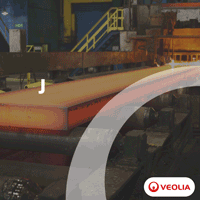SMS Siemag Supplying Continuous Pickling Line to Turkey’s Tezcan
03/23/2015 - Turkish steel service center Tezcan has placed an order with SMS Siemag for the supply of a continuous pickling line.
Tezcan will install the line at its Kartepe location near Izmir to improve the economy of its hot strip pickling operations and achieve an increase in output. Especially the high efficiency of the equipment was reason for Tezcan to decide in favor of a continuous pickling line and the turbulence pickling process from SMS Siemag, complete with a connected acid regeneration plant. Starting at the end of 2015, the line will pickle a yearly throughput of 1.3 million tons of hot strip, as a preparatory treatment for the downstream cold rolling and coating processes. Most of the material will be used in the construction industry as galvanized and/or color-coated cold strip.
SMS Siemag will supply the line and its numerous high-capacity components all from a single source, including the mechanical equipment, the process technology as well as the electrical and automation systems. In addition to the design and manufacture of the plant equipment, the supply will also include support during installation and commissioning. This comprehensive service package was a decisive reason for Tezcan to choose SMS Siemag as supplier.
The turbulence pickling technology provides a high-quality descaling result without overpickling. The process is characterized by low energy and acid consumption, low maintenance and operating costs, and long service life of the equipment. These economic, ecological and process-technological benefits convinced Tezcan about the quality of this system.
Hot-rolled low-carbon steel strips will be processed at speeds of up to 220 meters per minute. Strip thicknesses will range between 600 and 1,550 millimeters, strip widths between 1.5 and 5.0 millimeters.
The line will incorporate numerous high-capacity components with convincing performance features in terms of eco-friendliness, economic efficiency, process reliability, flexibility and product quality. A stretch leveler will prepare the strip for the pickling operation in the three downstream pickling tanks. The tanks will be made of plastic materials, facilitating a light-weight design. Each tank will have its own circulation system. A side trimmer with integrated scrap chopper will adjust the desired strip width and straighten the strip edges. In a DUMA-BANDZINK oiling machine, an oil film will be applied to the strip surface in an electrostatic process. A total of three horizontal strip accumulators will be integrated into the line in order to guarantee a continuous strip run.
The pickling acid will be directly processed in the fluidized-bed-type acid regeneration plant supplied by SMS Siemag. The plant will have a capacity to regenerate 7,500 liters hydrochloric acid per hour, enough to cover the line’s complete turnover of pickling liquor. Within a closed circuit, the regenerated liquor will be directly returned to the process and reused for pickling. Additionally, iron oxide will arise as a valuable by-product. This extremely energy-efficient regeneration plant, which complies with all applicable environmental regulations, is an excellent example of a technology effectively combining eco-friendliness and economic efficiency.

Pictured above: The turbulence pickling line achieves optimum descaling results

Pictured above: The new line will be used to pickle 1.3 million tons per year
SMS Siemag will supply the line and its numerous high-capacity components all from a single source, including the mechanical equipment, the process technology as well as the electrical and automation systems. In addition to the design and manufacture of the plant equipment, the supply will also include support during installation and commissioning. This comprehensive service package was a decisive reason for Tezcan to choose SMS Siemag as supplier.
The turbulence pickling technology provides a high-quality descaling result without overpickling. The process is characterized by low energy and acid consumption, low maintenance and operating costs, and long service life of the equipment. These economic, ecological and process-technological benefits convinced Tezcan about the quality of this system.
Hot-rolled low-carbon steel strips will be processed at speeds of up to 220 meters per minute. Strip thicknesses will range between 600 and 1,550 millimeters, strip widths between 1.5 and 5.0 millimeters.
The line will incorporate numerous high-capacity components with convincing performance features in terms of eco-friendliness, economic efficiency, process reliability, flexibility and product quality. A stretch leveler will prepare the strip for the pickling operation in the three downstream pickling tanks. The tanks will be made of plastic materials, facilitating a light-weight design. Each tank will have its own circulation system. A side trimmer with integrated scrap chopper will adjust the desired strip width and straighten the strip edges. In a DUMA-BANDZINK oiling machine, an oil film will be applied to the strip surface in an electrostatic process. A total of three horizontal strip accumulators will be integrated into the line in order to guarantee a continuous strip run.
The pickling acid will be directly processed in the fluidized-bed-type acid regeneration plant supplied by SMS Siemag. The plant will have a capacity to regenerate 7,500 liters hydrochloric acid per hour, enough to cover the line’s complete turnover of pickling liquor. Within a closed circuit, the regenerated liquor will be directly returned to the process and reused for pickling. Additionally, iron oxide will arise as a valuable by-product. This extremely energy-efficient regeneration plant, which complies with all applicable environmental regulations, is an excellent example of a technology effectively combining eco-friendliness and economic efficiency.
Pictured above: The turbulence pickling line achieves optimum descaling results
with low consumption of energy and pickling liquor,
while keeping maintenance and operating costs low.
Pictured above: The new line will be used to pickle 1.3 million tons per year
of hot strip as a preparation for its future application in the building sector.



-(220-x-200-px)-(130-x-130-px)-(220-x-200-px).jpg?lang=en-US&ext=.jpg)
.gif?width=200&height=200&mediaprotectionhash=ddb07947ad3b4ab959a83714461eccd5c6895f370695eb035a9ff7aa736f8ad9&ext=.gif)





